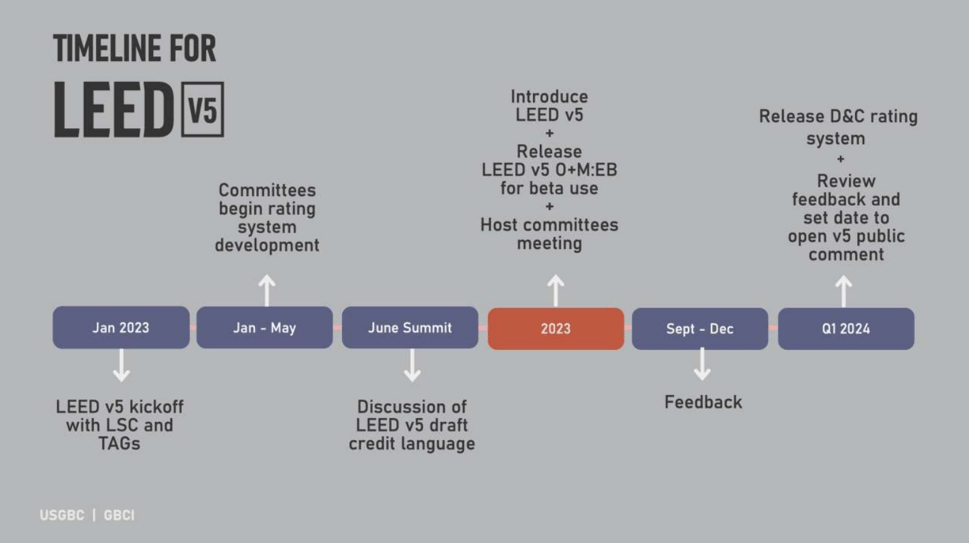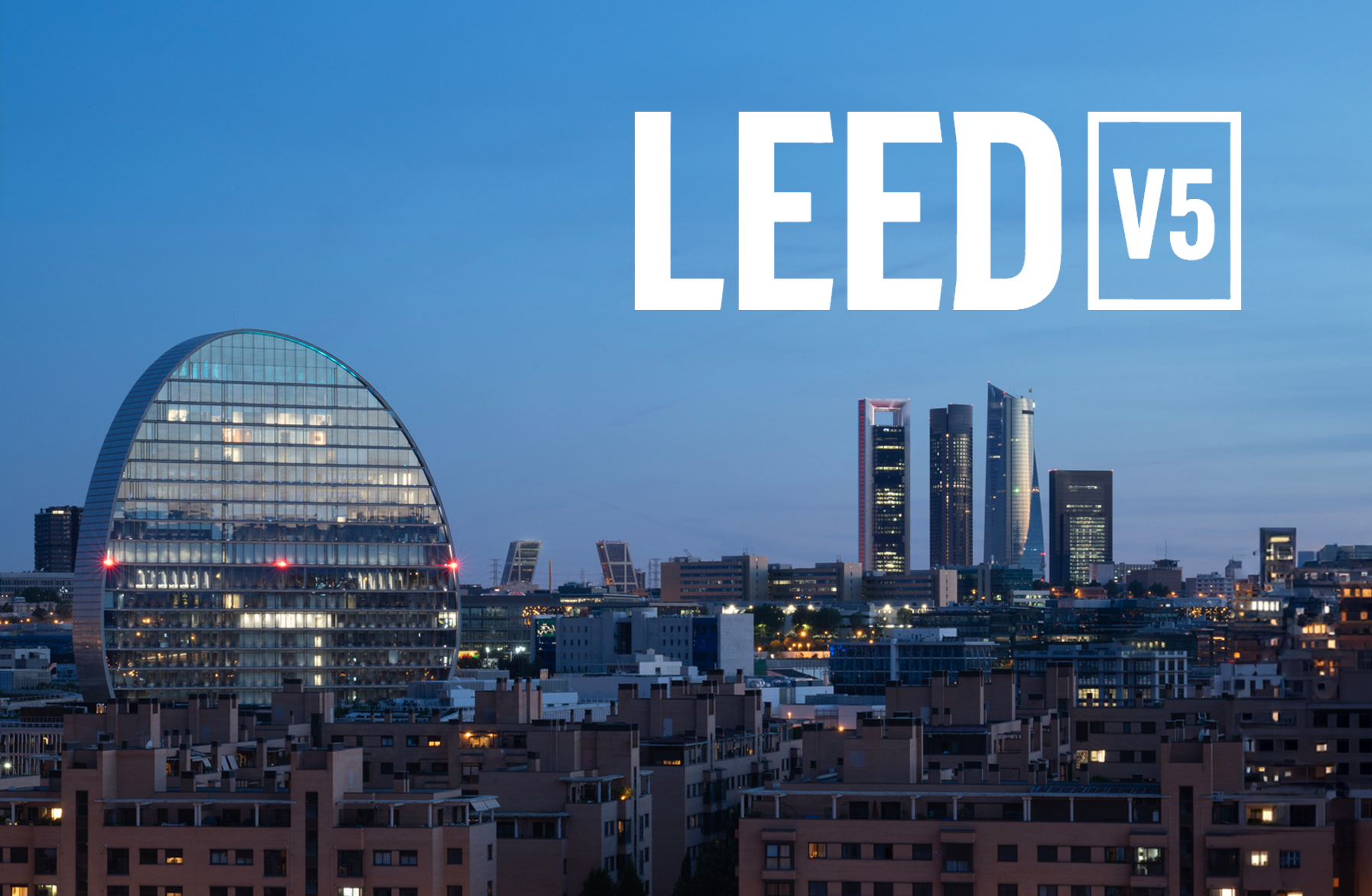After 7 years of the application of the fourth version of LEED, the U.S. Green Building Council has made a revision of the assessment methodology and has launched a beta version of LEED v5. This release represents a radical change in several aspects of the certification, in which we highlight a greater relevance in the decarbonization of buildings and a new way of seeing the credits and prerequisites organized.
50 projects from around the world participate in the beta phase of the new LEED v5.
At Zero Consulting, we had the pleasure of hearing the news directly from Kay Killmann, the managing director of GBCI Europe, who provided us with key insights into understanding the new approach to the LEED sustainable certification.
LEED v5's new approach
Regardless of whether O&M or D&NC projects are involved, LEED v5 highlights three system goals in its new approach: climate action, quality of life, and ecological conservation and restoration. These three pillars relate directly to ESG criteria (environmental, social and governance).
The weight of each of these goals in the certification is distributed as follows:
- Climate action: 50% of the weight of certification points.
- Quality of life: 25% of the weight of the certification points.
- Conservation and ecological restoration: 25% of the weight of certification points.
These three global goals are materialized through five principles that cut across all of them: decarbonization, resilience, health and well-being, equity and ecosystems. We will see later how these five principles will be addressed to achieve the three main goals.
When will LEED v5 be implemented?
LEED, a certification system with decades of history, remains a leader in sustainable certification by adapting to market transformations. The recent update, LEED v5, incorporates social, environmental, financial and legal changes, including the EU Taxonomy regulation, ensuring its relevance in the current context.

LEED v5 implementation schedule. Source: USGBC, GBCI
The first quarter of 2024 will mark the official launch of LEED v5 D&C (Design & Construction), aimed at new construction buildings. The expectation is that by 2025, LEED v5 will be fully implemented. Until the end of 2023, LEED is collecting feedback on the new version to maximize user satisfaction.
A relevant fact is that, starting with this version, LEED will adopt an update cycle every 5 years. Therefore, the v6 version is expected in 2030, responding to the continuous changes in the market and the social and environmental context.
The new scorecard: credits and prerequisites
LEED has presented the beta scorecard proposal with the credits and prerequisites for O&M certification. The novelty lies in the possibility to browse the credits and prerequisites in different ways: the traditional one and a cross-cutting one that takes into account the three main goals (Climate Action, Quality of Life and Ecological Conservation and Restoration). The new credit visualization version provides a more integrated view instead of the traditional presentation.
The scorecard with traditional LEED v5 view for building rehabilitation is as follows:
.png?width=1518&height=837&name=LEED%20v5%20Scorecard%20(Traditional).png)
Draft scorecard for LEED v5 (O&M), traditional version
Instead, the version of the scorecard organized according to the three general goals of LEED v5 is:
.png?width=1518&height=505&name=LEED%20v5%20Scorecard%20(New%20version).png)
Draft scorecard for LEED v5 (O&M), updated version segregated by objectives
How can the three LEED v5 goals be achieved?
As mentioned before, LEED v5 is structured around three general goals: climate action, quality of life, and ecological conservation and restoration. The way in which these objectives can be achieved is based on 5 principles. The following table details how the principles relate to each of the goals of the new version of LEED:
|
|
Decarbonization |
Resilience |
Health and well-being |
Equity |
Ecosystems |
|
Climate action |
Decarbonize swiftly |
Total carbon and peak demand reductions slow the rate of climate change |
• Indoor air improvements • Air and water quality improvements from total carbon reductions |
• Energy burden • Air and water quality improvements from total carbon reductions |
• Air and water quality improvements from total carbon reductions •Ecosystem impacts of nuclear/hydro power • Other impact categories within an LCA |
|
Quality of life |
Prioritize passive vs. mechanical efficiency for passive survivability |
Adapt for resilience |
Reduce stress and impact of climate change events on people |
Reduce and delay the impact of climate change on frontline communities |
Value and prioritize ecosystems services that bolster resilience |
|
Improved indoor air quality from no internal combustion |
Design for mental health resilience (comfort, wayfinding, acoustics) |
Invest in human health and well-being |
Consider health and well-being throughout the supply chain, on construction sites, transportation corridors, and downstream |
Value and prioritize ecosystem services that bolster human health and well-being |
|
|
Account for who causes climate change compared to who experiences it first and worst |
Bolster resilience for the most vulnerable |
Community support and engagement |
Create equitable outcomes |
Equitable access to nature |
|
|
Ecology |
Circularity/lifecycle analysis and reuse of materials |
Reduce flooding and extreme heat/wildfires |
Improved air and water quality, affordability |
Mitigate urban heat island impacts |
Restore ecosystems |
Summary table of LEED v5 goals and principles. Source: USGBC, GBCI
Ultimately, LEED v5 marks a significant shift in certification, prioritizing climate action, quality of life and ecological conservation. With principles such as decarbonization, resilience, equity, and a focus on health and wellness, the certification reflects a comprehensive commitment to sustainability. LEED v5 drives sustainable construction toward healthier, more equitable and resilient environments, demonstrating a long-term commitment to innovation and sustainability.
If you are interested in certifying your building with LEED, you can contact us so that we can advise you on the entire process of obtaining certification.


